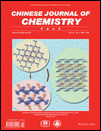Journal list menu
Export Citations
Download PDFs
Cover Picture
Cover Picture: Synthesis, Characterizations, Magnetism and Thermal Degradation of a 2-Fold Interpenetrated 3D Cobalt-Organic Framework (Chin. J. Chem. 3/2014)
- Page: 197
- First Published: 17 March 2014

The cover picture shows a new coordination polymer, [Co2(L)2(4,4′-bipy)]n·3nH2O (1) based on 5-(3-methyl-5-phenyl-4H-1,2,4-triazol-4-yl)isophthalic acid (H2L) and 4,4′-bipyridine (4,4′-bipy), which has been hydrothermally synthesized and characterized by single-crystal X-ray diffraction, XRPD, IR, and elemental analysis. The 2D triangle networks were linked by the bridging 4,4′-bipy ligand to give rise to a 2-fold interpenetrated 3D architecture. We can define Co(II) ions as 4-connected nodes and the L2− ligands as 3-connected nodes. Thus, the 3D structure can be described as a 2-fold parallel interpenetrated ins InS 3,4-conn topology. Variable-temperature (2–300 K) magnetic susceptibility measurements indicate that compound 1 exhibits antiferromagnetic interactions between the Co(II) paramagnetic centers. Compound 1 was heated to produce Co3O4. The particle size of the Co3O4 phase is 400–800 nm. More details are discussed in the article by Liu et al. on page 227–232.
Contents
Full Papers
Study of Linear and Nonlinear Optical Properties of Four Derivatives of Substituted Aryl Hydrazones of 1,8-Naphthalimide
- Pages: 205-211
- First Published: 13 March 2014

Four 1,8-naphthalimide hydrazone molecules with different electron donor groups have been applied in the study of linear and nonlinear optical (NLO) properties. Through the modification of the structure, the nonlinear optical properties of these compounds at different wavelengths (532 nm and 800 nm) were well tuned.
Efficient CS Cross-Coupling of Thiols with Aryl Iodides Catalyzed by Cu(OAc)2·H2O and 2,2′-Biimidazole
- Pages: 212-218
- First Published: 05 March 2014
Multicomponent Reactions for Diverse Synthesis of N-Substituted and NH 1,4-Dihydropyridines
- Pages: 219-226
- First Published: 13 March 2014
Synthesis, Characterizations, Magnetism and Thermal Degradation of a 2-Fold Interpenetrated 3D Cobalt-Organic Framework
- Pages: 227-232
- First Published: 17 February 2014

A new coordination polymer, [Co2(L)2(4,4′-bipy)]n·3nH2O (1) based on 5-(3-methyl-5-phenyl-4H-1,2,4-triazol-4-yl)isophthalic acid (H2L) and 4,4′-bipyridine (4,4′-bipy) has been hydrothermally synthesized and characterized by single-crystal X-ray diffraction, XRPD, IR, and elemental analysis. Temperature-dependent magnetic susceptibility and thermal degradation for 1 were also studied. A 2-fold parallel interpenetrated ins InS 3,4-conn topology has been obtained.
Investigation of Platinum Dispersed on Reduced Graphene Oxide-supported Tungsten Carbide via Sacrificial Cu Adlayers for Methanol Oxidation
- Pages: 233-240
- First Published: 05 March 2014
Helical Poly(α,β-unsaturated ketone) with Bulky Pendant of Binaphthyl from Anionic Polymerization of ((−)-Menthyl (S)-6′-Acrylyl-2′-methyloxy-1,1′-binaphthalene-2-carboxylate
- Pages: 241-247
- First Published: 13 March 2014
All-Atom Molecular Dynamics Simulation of Structure and Diffusion of Hydrophilic Antistatic Agents in Polypropylene
- Pages: 248-256
- First Published: 05 March 2014

Based on glycerol monostearate, we propose five additives of different polarity by attuning the number of oxyethyl groups. When embedded in polypropylene matrix, due to the gauche effect of the dihedral angles, the polar parts of these additives form helix structures. The diffusion coefficient of the additives depends on their molecular conformations and decreases monotonously with increasing polarity. These results are expected to be helpful in rational design of hydrophilic antistatic agents in polymeric materials.
Highly Efficient Au/TiO2 Catalyst for One-pot Conversion of Nitrobenzene to p-Aminophenol in Water Media
- Pages: 257-262
- First Published: 17 February 2014
Direct Electrochemistry of Horseradish Peroxidase Immobilized in a Low Molecular Weight Gel
- Pages: 263-268
- First Published: 17 February 2014
Accurate Prediction of IrH Bond Dissociation Enthalpies by Density Functional Theory Methods
- Pages: 269-275
- First Published: 05 March 2014

The accuracies of different theoretical methods (including different density functional theory methods, basis sets and solvation models) in prediction of the IrH BDEs have been examined. It is found that the TPSS/(LanL2DZ: 6-31G(d)) method is relatively more accurate than the other gas-phase calculation methods, and can well simulate the IrH BDEs in low-polarity solvents (such as chlorobenzene and dichloroethane).
Note
Synthesis of [3,3′-Di-sec-butyl-4′-(2-dimethylaminoethoxy)biphenyl-4-yl-oxy]acetic Acid
- Pages: 276-279
- First Published: 05 March 2014











![Synthesis of [3,3′-Di-sec-butyl-4′-(2-dimethylaminoethoxy)biphenyl-4-yl-oxy]acetic Acid](/cms/asset/24fbd976-9919-41dd-9b83-95f16653c824/mcontent.jpg)




